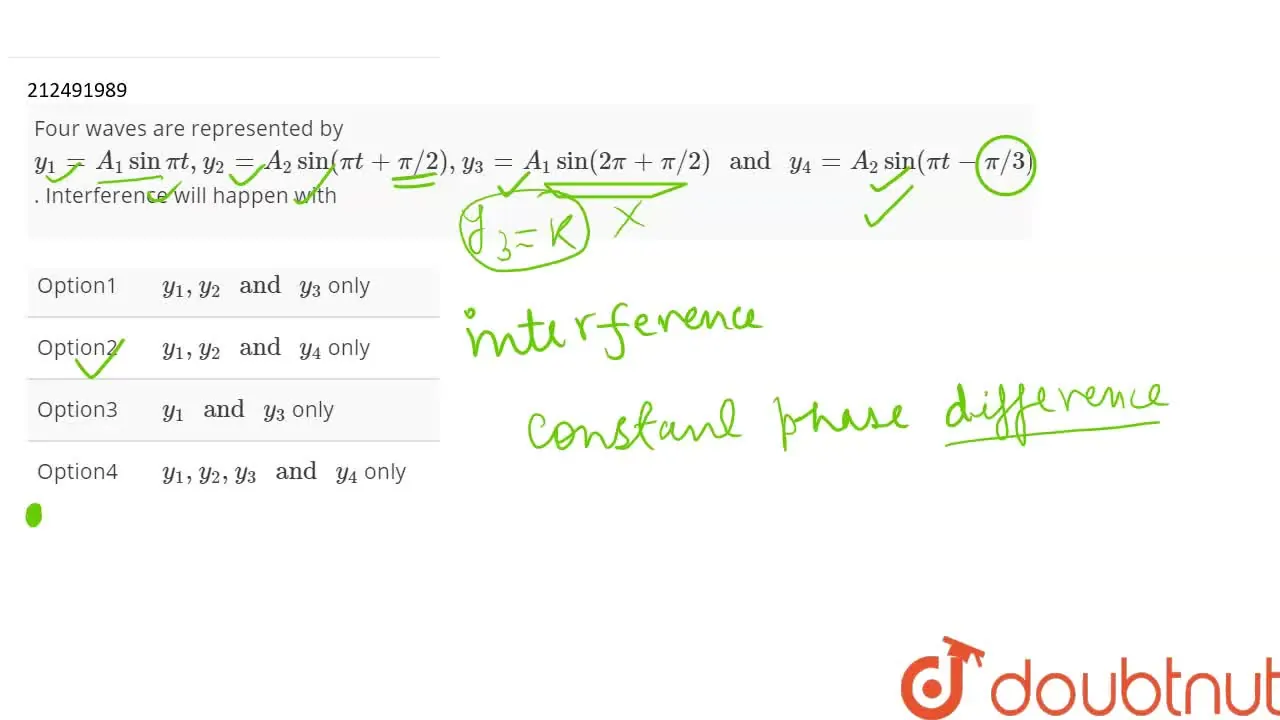Four waves are represented by y1=A1sinπt,y2=A2sin(πt+π/2),y3=A1sin(2π+π/2) and y4=A2sin(πt−π/3). Interference will happen with
y1,y2 and y3 only
y1,y2 and y4 only
y1 and y3 only
y1,y2,y3 and y4 only
The correct Answer is:D
Step by step video, text & image solution for Four waves are represented by y_1=A_1 sin pi t, y_2= A_2 sin (pi t+pi"/"2),y_3=A_1sin (2pi+pi"/"2) " and "y_4=A_2sin (pi t - pi"/"3). Interference will happen with by Physics experts to help you in doubts & scoring excellent marks in Class 12 exams.
Related Playlists
- BOOK - MOTIONCHAPTER - SOUND WAVESEXERCISE - EXERCISE - 1 (SECTION C)9videos
SOUND WAVES
- BOOK - MOTIONCHAPTER - SOUND WAVESEXERCISE - EXERCISE - 1 (SECTION D)8videos
SOUND WAVES
- BOOK - MOTIONCHAPTER - SOUND WAVESEXERCISE - Exercise - 3 (Section - B)14videos
SOUND WAVES
- BOOK - MOTIONCHAPTER - SIMPLE HARONIC MOTION EXERCISE - EXERCISE -4 (Leve-II) [ JEE 2011]11videos
SIMPLE HARONIC MOTION
- BOOK - MOTIONCHAPTER - SURFACE TENSIONEXERCISE - Exercise - 3 | Section - B Previous Year Problems | AIEEE12videos
SURFACE TENSION
Similar Questions
Four light waves are represented by
(i) y=a1sinωt
(ii) y=a2sin(ωt+φ)
(iii) y=a1sin2Ωt
(iv) y=a2sin2(ωt+φ)
Interference fringes may be observed due to superposition ofView SolutionFour waves are expressed as
1. y1=a1sinωt
2. y2=a2sin2ωt
3. y3=a3cosωt
4. y4=a4sin(ωt+ϕ)
The interference is possible betweenView SolutionFour different independent waves are represented by
y1=a1sinωt
y2=a2sin2ωt
y3=a3cosωt
y4=a4sin(ωt+λ3)
With which of two waves interference is possibleView SolutionTwo coherent waves are represented byy1=a1cosωt and y2=a2cos(π2−ωt). Their resultant intensity after interference will be-
View SolutionTwo waves represented by y1=10sin(2000πt) and y2=10sin(2000πt+π/2) superposed at any point at a particular instant. The resultant amplitude is
View SolutionIf two SHMs are represented by equations y1=5sin(2πt+π/6)andy2=5[sin(3π)+√3cos(3πt)]. Find the ratio of their amplitudes.
View SolutionIf two SHMs are represented by equations y1= 4 sin[3πt + (π/3)], y2= 4 [sin(3πt) +√3 cos (3πt)], then the ratio of their amplitudes is
View SolutionTwo simple harmonic motions are represented by the equations y1=2(√3cos3πt+sin3πt) and y2=3sin(6πt+π6)
View SolutionTwo simple harmonic motions are represented by y1=5[sin2πt+√3cos2πt]andy2=5sin(2πt+π4)
The ratio of their amplitudes isView SolutionFour simple harmonic vibrations
y1=8sinωt, y2=6sin(ωt+π/2), y3=4sin(ωt+π), y4=2sin(ωt+3π/2)
are susperimposed on each other. The resulting amplitude and phase are respectively.View Solution


